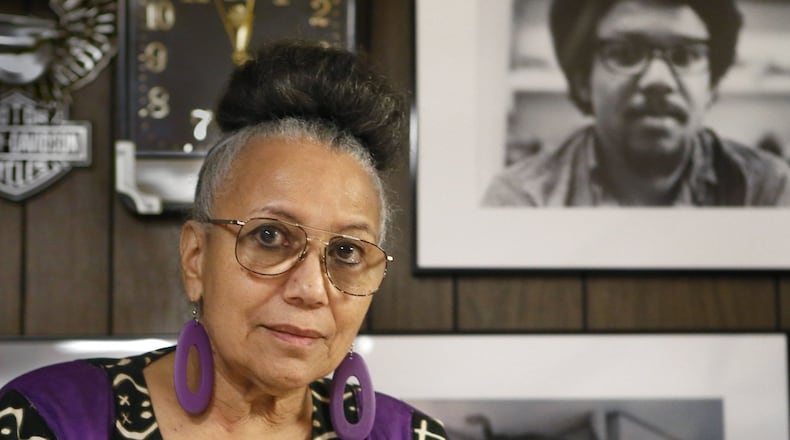Not long ago, Atlanta artist Charmaine Minnifield was working with her mentor and friend Doris A. Derby on some of Derby’s photographs when Minnifield paused to ask which images most stirred her soul.
Those of the women and the children, said Derby, an activist and photographer, who spent years documenting the civil rights movement in the South.
“She felt that their role in the civil rights movement was less acknowledged and honored but were the most paramount,” said Minnifield. “She witnessed their existence inside the freedom movement and how they resisted Jim Crow in their every-day lives.”
Derby died Monday at age 82 after a battle with cancer, according to actor Bob Banks, her husband of 26 years. Arrangements are pending.
She was 5-feet, 1-inch in stature, but her personality and drive were gigantic. It didn’t bother her that most photographers covering the movement were male, he said.
“She wasn’t intimidated at all,”Banks said. “She was a strong woman.”
Derby, who earned degrees from Hunter College in New York and The University of Illinois Urbana-Champaign, was also an educator. She was a retired adjunct professor of anthropology at Georgia State University and was founding director of the Office of African-American Student Services and Programs at the school.
Deborah Willis, a writer, curator and chairwoman of the Department of Photography & Imaging at the Tisch School of the Arts at New York University, credited Derby with “changing the visual language” of the movement, particularly as it applied to women and children and the impact discrimination had on them.
“Her work was critical because she not only photographed the drama on the streets, but she also captured the quiet drama that affected families. Her sensitivity looking at women was the most important aspect for me.”
Credit: Bob Andres
Credit: Bob Andres
Among her thousands of photographs are pictures of ordinary people doing ordinary things — a woman hanging clothes on the front porch; an older man standing behind two young girls, perhaps his granddaughters, as they prepare to attend a political meeting in Jackson, Mississippi, in 1968; and members of a quilting guild in Beaufort, South Carolina.
A book of Derby’s photos was recently published in “A Civil Rights Journey” by London-based Mack Books.
Her work is also included in several collections including a permanent one housed at the Stuart A. Rose Manuscripts, Archives, & Rare Book Library at Emory University.
The collection includes her work with the Student Nonviolent Coordinating Committee, Free Southern Theater, the Poor People’s Corporation, the Mississippi Freedom Project and the Child Development Program of Mississippi.
Born Nov. 11, 1939, and a native of New York, activism ran in her blood.
Her maternal grandmother and uncle were charter members of a NAACP chapter in the 1920s.
Her father once refused to accept an athletics award from the University of Pennsylvania after he was told to use the service elevator, and he also fought for the rights of Black civil service employees.
At 16, Derby also joined the NAACP. She participated in civil rights activities across the South.
Friends who visited her describe her home as like a museum. She loved traveling and collected instruments from all over the world. And she loved to dance. Banks said his wife continued to do salsa dancing into her 80s.
Susan Ross first met Derby in the 1970s and quickly brought her into the fold of Sistagraphy, a collective of Black women photographers and filmmakers.
It was a natural fit, said Ross, co-founder of the group.
“No matter what kind of exhibit we had, Doris could find something in her vast archives that hit our theme,” she said.
Equally important, though, said Ross was Derby’s work as an educator and with Black students on campuses.
“She always wanted to empower students and other people to find their gifts,” Ross said. “To students, she was a rock.”
Millicent Brown, a retired history professor and activist in Charleston, South Carolina, met Derby in 1969 when both worked with SNCC in Mississippi.
Derby had been in the state since the early 1960s, working on voter registration drives and other programs, when Brown arrived.
“She taught me that a college-educated, middle class Black woman can’t come into Mississippi and act like people aren’t already wise and know a lot,” said Brown. “She taught me how to respect people where they are.”
When many of the out-of-state activists began to leave, Derby stayed to help Mississippi residents who lost their jobs or were penalized because of their work in the movement.
Ross, whose father, who was also part of the small community of Black anthropologists in the nation, said Derby also documented Black quilters, dollmakers and basket weavers in South Carolina and Coastal Georgia before it became popular.
“Doris was about identifying culture broadly and how every day people lived,” she said. “If you look at her work over the course of her lifetime, it was all about what people were doing to empower themselves. She had a special insight into the relationship between culture and society. "
About the Author
Keep Reading
The Latest
Featured




